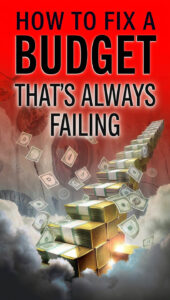Now Reading: How to Fix a Budget That’s Always Failing 💸
-
01
How to Fix a Budget That’s Always Failing 💸
How to Fix a Budget That’s Always Failing 💸
Have you ever sat down with a fresh budget, high on motivation… only to feel like a failure by the end of the month?
If that sounds like your story, you’re so not alone. Most women—whether single moms juggling it all, ambitious professionals with big dreams, or homemakers trying to stretch every dollar—have been there. We make the spreadsheet. We even color-code it. But somehow, reality never fits into those neat little boxes.
So, what’s going wrong? Why does your budget keep falling apart even when you’re genuinely trying?
Let’s dig into the real, raw truth—and fix it.

💔 Step 1: Stop Budgeting for a Perfect Month
Real life is messy. One week it’s a birthday dinner you didn’t budget for. The next, your toddler needs new shoes (again!). If your budget doesn’t have room for “life”, it will break—every. single. time.
Fix it: Add a “Life Happens” category to your budget—$100–$150 if you can. It’s not a luxury; it’s your cushion. The month you don’t need it, roll it into savings.
💸 Step 2: Be Honest About What You Actually Spend
Most budgets fail because they’re based on what we wish we spent, not what we really spend. Like planning to spend $200 on groceries when you’ve never once managed to stay under $400. That’s setting yourself up for guilt and disappointment.
Fix it: Track your spending (no skipping the Starbucks runs 😅) for the past 2-3 months. This is your truth baseline. Start your budget from there, not a fantasy version of it.
🔁 Step 3: Make It Flexible—Not Fragile
A good budget bends. A bad one breaks. Think of your budget like yoga pants, not skinny jeans. If one category overshoots, another can tighten. If you lose $200 in income this month, your budget shouldn’t crumble.
Fix it: Use a zero-based budgeting method, where every dollar has a job. But build in flex funds that can shift categories based on your needs that week.
🔍 Step 4: Cut the “Invisibility” Expenses
You know those sneaky little expenses that don’t seem like a big deal… until you realize they’ve eaten half your budget?
Yep, that $10 monthly app subscription you forgot, or the “just one” Target run that turns into $87 worth of throw pillows.
Fix it: Review your bank statements. Highlight everything that made you go, “Wait, I paid for that?” Cancel what doesn’t serve your goals. Automate reminders for renewals.
🌸 Step 5: Align Your Budget with What Matters to You
Sometimes a budget fails not because it’s wrong, but because it’s not personal. It doesn’t reflect what you value. And if your money isn’t going toward the things that make your life richer (emotionally, not just financially), you’ll always feel restricted and unhappy.
Fix it: Make space in your budget for joy. Whether that’s a monthly girls’ brunch, a mani-pedi, or saving for your solo trip to Italy next summer—prioritize what lights you up.
💬 Real Talk, Sis…
If your budget keeps failing, it’s not because you are a failure. It’s because your budget probably wasn’t designed to fit the real you—your life, your needs, your dreams, your chaos. The good news? You don’t need to scrap it. You just need to reshape it.
And trust me… once your budget starts feeling like a tool of freedom instead of punishment, everything changes.
Stay with me—because in the next steps, we’ll go even deeper. You’ll learn how to create a rhythm with your budget that doesn’t just work but makes you feel empowered.
So now that you’ve laid the foundation—flexible, honest, and aligned with what truly matters to you—it’s time to move into the rhythm that makes your budget not just “survive,” but thrive.
Because here’s the truth:
A budget isn’t something you build once and forget. It’s something you live with, check in with, and evolve with—just like any healthy relationship.
Let’s fix the deeper cracks most women don’t even realize are holding them back 👇
🔁 Step 6: Create a “Money Check-In” Ritual
Think of this like self-care for your bank account.
It’s not about spreadsheets and stress. It’s about awareness and alignment. One of the biggest reasons budgets fall apart is because we don’t check in until it’s too late.
Fix it:
Set a weekly money date with yourself—Sunday evenings or Monday mornings work best. Light a candle, make tea, open your budget app or journal, and ask:
-
What came in this week?
-
What went out?
-
What surprised me?
-
What do I need to adjust for the week ahead?
You’ll be amazed at how just 15 minutes can change the way you feel about money.
📅 Step 7: Use the “Three-Check System”
Sometimes we overspend not because we’re reckless, but because we’re on autopilot.
Here’s a powerful habit: the Three-Check Rule before every non-essential purchase.
Ask yourself:
-
Do I really need this, or am I trying to soothe something else?
-
Will I still feel good about this purchase next week?
-
Can I afford it without sacrificing what matters more later?
If all three are a clear YES, go for it. If not? Walk away with your head high—you just saved future-you a headache.
💰 Step 8: Automate the Essentials
Let’s face it, life gets busy. And even with the best intentions, we miss due dates, forget savings goals, or fall into old habits.
Fix it:
Automate these 3 key things:
-
Bills (especially minimum payments like rent, utilities, subscriptions)
-
Savings (even if it’s just $25 a week!)
-
Debt repayments (so you never miss and stack interest)
Let your money system run quietly in the background, so you can focus on the living part of life.
💡 Step 9: Plan for the Unpredictable (aka Emotional Spending)
We all have those days. You’re tired, overwhelmed, maybe a little lonely… and suddenly, you’re scrolling through Amazon looking for something—anything—that makes you feel better.
This isn’t about shame. It’s about building a safety net for your emotions.
Fix it:
Create an “Emotional Buffer” in your budget. Maybe $40–$50 a month labeled “Mood Lifters.” That way, if you do impulse-buy a cozy blanket or a scented candle, it’s planned—not destructive.
And when you don’t need it? Roll it into something bigger that feeds your joy long-term.
🎯 Step 10: Set Micro-Goals (and Celebrate Them!)
Sometimes the reason our budget feels like it’s failing is because we’re only focused on huge, overwhelming goals. Pay off $10k debt. Save $5k for a trip. It feels so far away… so we give up.
Fix it:
Break big goals into tiny wins:
-
Save $100 this month
-
Have 3 no-spend days this week
-
Make one extra debt payment this quarter
And celebrate those wins like crazy. Light a candle. Do a happy dance. Call your best friend.
Because progress—even the tiniest step—is worth honoring.
💬 Final Thought, From One Woman to Another…
If your budget hasn’t worked in the past, it doesn’t mean you’re bad with money.
It means you’re human.
It means you’ve been navigating bills, emotions, surprises, and dreams—sometimes all at once.
And yet here you are. Still trying. Still hoping. Still ready to turn it around.
That? That’s power, sis. That’s resilience.
Your budget doesn’t need to be fancy.
It needs to be real, kind, and built around your life—not against it.
Save this to your “Money Motivation” board 🖤
Because every woman deserves a budget that lifts her up—not weighs her down.














